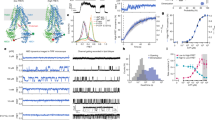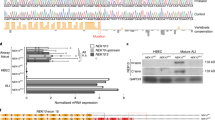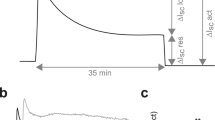Abstract
Cystic fibrosis (CF) is a disease caused by mutations in the cystic fibrosis transmembrane conductance regulator (CFTR). Initially, Cl- conductance in the sweat duct was discovered to be impaired in CF1, a finding that has been extended to all CFTR-expressing cells2,3,4. Subsequent cloning of the gene5,6 showed that CFTR functions as a cyclic-AMP-regulated Cl- channel7; and some CF-causing mutations inhibit CFTR Cl- channel activity2,3,4,8. The identification of additional CF-causing mutants with normal Cl- channel activity indicates, however, that other CFTR-dependent processes contribute to the disease. Indeed, CFTR regulates other transporters3,4, including Cl--coupled HCO-3 transport9,10. Alkaline fluids are secreted by normal tissues, whereas acidic fluids are secreted by mutant CFTR-expressing tissues11, indicating the importance of this activity. HCO-3 and pH affect mucin viscosity12,13 and bacterial binding14,15. We have examined Cl--coupled HCO-3 transport by CFTR mutants that retain substantial or normal Cl- channel activity. Here we show that mutants reported to be associated with CF with pancreatic insufficiency do not support HCO-3 transport, and those associated with pancreatic sufficiency show reduced HCO-3 transport. Our findings demonstrate the importance of HCO-3 transport in the function of secretory epithelia and in CF.
This is a preview of subscription content, access via your institution
Access options
Subscribe to this journal
Receive 51 print issues and online access
$199.00 per year
only $3.90 per issue
Buy this article
- Purchase on Springer Link
- Instant access to full article PDF
Prices may be subject to local taxes which are calculated during checkout



Similar content being viewed by others
References
Quinton, P. M. Chloride impermeability in cystic fibrosis. Nature 301, 421–422 (1983).
Quinton, P. M. Physiological basis of cystic fibrosis: a historical perspective. Physiol. Rev. 79, S3–S22 (1999).
Pilewski, J. M. & Frizzell, R. A. Role of CFTR in airway disease. Physiol. Rev. 79, S215–S255 (1999).
Grubb, B. R. & Boucher, R. C. Pathophysiology of gene-targeted mouse models for cystic fibrosis. Physiol. Rev. 79, S193–S213 (1999).
Rommens, J. M. et al. Identification of the cystic fibrosis gene: chromosome walking and jumping. Science 245, 1059–1065 (1989).
Riordan, J. R. et al. Identification of the cystic fibrosis gene: cloning and characterization of complementary DNA. Science 245, 1066–1073 (1989).
Sheppard, D. N. & Welsh, M. J. Structure and function of the CFTR chloride channel. Physiol. Rev. 79, S23–S45 (1999).
Argent, B. E. & Case, R. M. in Physiology of the Gastrointestinal Tract 3rd edn (ed. Johnson, L. R.) 1478–1498 (Raven, New York, 1994).
Lee, M. G. et al. Regulation of Cl-/HCO-3 exchange by cystic fibrosis transmembrane conductance regulator expressed in NIH 3T3 and HEK 293 cells. J. Biol. Chem. 274, 3414–3421 (1999).
Lee, M. G. et al. Cystic fibrosis transmembrane conductance regulator regulates luminal Cl-/HCO-3 exchange in mouse submandibular and pancreatic ducts. J. Biol. Chem. 274, 14670–14677 (1999).
Kopelman, H. et al. Impaired chloride secretion, as well as bicarbonate secretion, underlies the fluid secretory defect in the cystic fibrosis pancreas. Gastroenterology 95, 349–355 (1988).
Veerman, E. C., Valentijn-Benz, M. & Nieuw Amerongen, A. V. Viscosity of human salivary mucins: effect of pH and ionic strength and role of sialic acid. J. Biol. Buccale 17, 297–306 (1989).
Bhaskar, K. R. et al. Profound increase in viscosity and aggregation of pig gastric mucin at low pH. Am. J. Physiol. 261, G827–G832 (1991).
Wanke, C. A., Cronan, S., Goss, C., Chadee, K. & Guerrant, R. L. Characterization of binding of Escherichia coli strains which are enteropathogens to small-bowel mucin. Infect. Immun. 58, 794–800 (1990).
Veerman, E. C. et al. Sulfated glycans on oral mucin as receptors for Helicobacter pylori. Glycobiology 7, 737–743 (1997).
Seibert, F. S. et al. Disease-associated mutations in cytoplasmic loops 1 and 2 of cystic fibrosis transmembrane conductance regulator impede processing or opening of the channel. Biochemistry 36, 11966–11974 (1997).
Illek, B. et al. Defective function of the cystic fibrosis-causing missense mutation G551D is recovered by genistein. Am. J. Physiol. 277, C833–C839 (1999).
Anderson, M. & Welsh, M. J. Regulation by ATP and ADP of CFTR chloride channels that contain mutant nucleotide-binding domains. Science 257, 1701–1704 (1992).
Vankeerberghen, A. et al. Characterization of 19 disease-associated missense mutations in the regulatory domain of the cystic fibrosis transmembrane conductance regulator. Hum. Mol. Genet. 7, 1761–1769 (1998).
Seibert, F. S. et al. Cytoplasmic loop three of cystic fibrosis transmembrane conductance regulator contributes to regulation of chloride channel activity. J. Biol. Chem. 271, 27493–27499 (1996).
Seibert, F. S. et al. Disease-associated mutations in the fourth cytoplasmic loop of cystic fibrosis transmembrane conductance regulator compromise biosynthetic processing and chloride channel activity. J. Biol. Chem. 271, 15139–15145 (1996).
Gray, M. A., Plant, S. & Argent, B. E. cAMP-regulated whole cell chloride currents in pancreatic duct cells. Am. J. Physiol. 264, C591–C602 (1993).
Poulsen, J. H., Fischer, H., Illek, B. & Machen, T. E. Bicarbonate conductance and pH regulatory capability of cystic fibrosis transmembrane conductance regulator. Proc. Natl Acad. Sci. USA 91, 5340–5344 (1994).
Linsdell, P. et al. Permeability of wild-type and mutant cystic fibrosis transmembrane conductance regulator chloride channels to polyatomic anions. J. Gen. Physiol. 110, 355–364 (1997).
Sheppard, D. N. et al. Mutations in CFTR associated with mild-disease-form Cl- channels with altered pore properties. Nature 362, 160–164 (1993).
Fulmer, S. B., Schwiebert, E. M., Morales, M. M., Guggino, W. B. & Cutting, G. R. Two cystic fibrosis transmembrane conductance regulator mutations have different effects on both pulmonary phenotype and regulation of outwardly rectified chloride currents. Proc. Natl Acad. Sci. USA 92, 6832–6836 (1995).
Stutts, M. J. et al. CFTR as a cAMP-dependent regulator of sodium channels. Science 269, 847–850 (1995).
Mall, M., Bleich, M., Greger, R., Schreiber, R. & Kunzelmann, K. The amiloride-inhibitable Na+ conductance is reduced by the cystic fibrosis transmembrane conductance regulator in normal but not in cystic fibrosis airways. J. Clin. Invest. 102, 15–21 (1998).
Reddy, M. M., Light, M. J. & Quinton, P.M. Activation of the epithelial Na+ channel (ENaC) requires CFTR Cl- channel function. Nature 402, 301–304 (1999).
McNicholas, C. M. et al. Sensitivity of a renal K+ channel (ROMK2) to the inhibitory sulfonylurea compound glibenclamide is enhanced by coexpression with the ATP-binding cassette transporter cystic fibrosis transmembrane regulator. Proc. Natl Acad. Sci. USA 93, 8083–8088 (1996).
Acknowledgements
We thank H. Cuppens from the European CF Consortium for informing us that the G970R mutation results in pancreatic insufficiency. This work was supported by a grant from the NIH.
Author information
Authors and Affiliations
Corresponding author
Supplementary information
Rights and permissions
About this article
Cite this article
Choi, J., Muallem, D., Kiselyov, K. et al. Aberrant CFTR-dependent HCO-3 transport in mutations associated with cystic fibrosis. Nature 410, 94–97 (2001). https://doi.org/10.1038/35065099
Received:
Accepted:
Issue Date:
DOI: https://doi.org/10.1038/35065099
This article is cited by
-
An overview of CFTR mutation profiles and assisted reproductive technology outcomes in Chinese patients with congenital obstructive azoospermia
Journal of Assisted Reproduction and Genetics (2024)
-
Cftr deletion in mouse epithelial and immune cells differentially influence the intestinal microbiota
Communications Biology (2022)
-
Cellular and functional heterogeneity of the airway epithelium
Mucosal Immunology (2021)
-
Genetics of the congenital absence of the vas deferens
Human Genetics (2021)
-
Physiological mechanisms determining eccrine sweat composition
European Journal of Applied Physiology (2020)
Comments
By submitting a comment you agree to abide by our Terms and Community Guidelines. If you find something abusive or that does not comply with our terms or guidelines please flag it as inappropriate.



